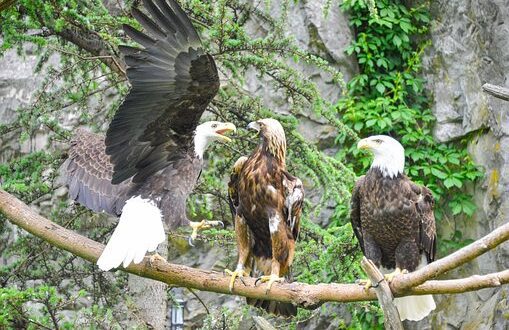Do Eagles Hunt at Night? The short answer is mostly no, but as it turns out, the explanation is not as straightforward as you might think.
In this article, we’ll delve into the world of eagles and their hunting habits, exploring the reasons behind their diurnal lifestyle and the fascinating adaptations that allow them to thrive in their natural habitats.
So buckle up, eagle-eyed readers, and get ready for a wild ride!
Do eagles hunt at night?
No. Eagles are diurnal birds, meaning that they are active during the day and hunt during daylight hours.
Eagles have excellent eyesight, which allows them to spot prey from great distances, and they rely on this vision to hunt.
However, there are some species of eagles, such as the African crowned eagle, which are known to hunt during dawn and dusk, which are the transitional periods between day and night.
While they may occasionally hunt during low-light conditions, it’s not common for eagles to hunt at night because their vision is adapted to daylight.
Scientific Evidence
Scientific studies have confirmed that some eagle species, such as the spotted eagle and the tawny eagle, are active hunters at night.
These nocturnal hunters have developed special adaptations, such as larger eyes and enhanced night vision, to help them catch prey in low-light conditions.
These adaptations allow them to detect prey movement and hunt more effectively at night.
Comparing Hunting Behaviors
Comparing the hunting behaviors of different eagle species can provide valuable insights into how these birds have evolved to survive in their respective habitats.
While not all eagle species hunt at night, those that do demonstrate remarkable skill and adaptability.
By understanding the differences in hunting behaviors, we can gain a deeper appreciation for the complexity of these magnificent birds.
Do eagles fly at night?
Eagles are known for their soaring flights during the day, but do they take to the skies at night?
The answer is yes, some eagle species are active flyers at night.
When flying at night, eagles rely on their exceptional vision and keen hearing to navigate and locate prey.
They often fly at lower altitudes and slower speeds to conserve energy and increase their chances of detecting prey.
Can eagles see at night?
Eagles are known for their exceptional eyesight, but can they see in the dark?
Based on scientific research, eagles have been shown to possess superior night vision, making them formidable nocturnal predators.
Their eyes have evolved to adapt to low-light conditions, with a larger pupil size and a higher density of rod cells. These adaptations allow them to see more clearly in dim lighting, making it easier to detect prey at night.
Why can’t they see at night?
While eagles have impressive night vision, they still face certain limitations. Eagles’ visual acuity decreases in very low light conditions, and their ability to perceive colors is reduced.
Additionally, factors such as fog, rain, and glare from artificial light sources can further impede their vision.
Different factors affect an eagle’s vision at night and can help readers understand the challenges these birds face.
Scientific studies have shown that eagles use their other senses, such as hearing and touch, to compensate for their visual limitations.
What time of day are eagles most active?
Eagles’ activity patterns vary depending on the species and the environment they inhabit.
Some eagle species, such as the golden eagle, are more active during the early morning and late afternoon when the temperature is cooler and prey is more active.
Other eagle species, such as the bald eagle, are active during daylight hours and may spend more time resting during the hottest part of the day.
The peak activity time for different eagle species can give readers a deeper understanding of these birds’ behavior.
An analogy that can be used to describe how the time of day affects an eagle’s hunting behavior is to compare it to a human’s appetite – we tend to be more hungry during certain times of the day.
Similarly, eagles’ hunting behavior may be influenced by the availability of prey during certain times of the day.
Making comparisons between eagle’s activity patterns in different environments can also provide valuable insights into how these birds have adapted to their respective habitats.
When do they hunt the most?
Eagles are known for their impressive hunting skills, but when are they most active in their pursuit of prey?
This is a common question asked by many, and the answer is not so simple.
In this section, we will explore the peak activity time for eagles and how it varies depending on their species and the time of year.
The Factors Affecting Eagle’s Hunting Behaviors
Several factors can affect an eagle’s hunting behavior, including prey availability, habitat, and seasonality.
Different eagle species also have varying hunting habits, which can be influenced by their size, strength, and agility.
Observations and Evidence
Personal observations and scientific studies have shown that eagles may hunt more frequently during certain times of the year.
For example, during the winter months, when prey is scarce, eagles may need to hunt more frequently to survive.
Additionally, eagles may adjust their hunting behavior based on the availability of prey in their environment.
Eagle’s Most Active Time of Day
The peak activity time for eagles can vary depending on their species and habitat.
Some species, such as the golden eagle, are diurnal and hunt primarily during the day, while others, such as the northern hawk-owl, are crepuscular and hunt during the early morning and late afternoon.
What do eagles do at night?
Eagles’ behaviors differ significantly between day and night.
While they may spend most of their day hunting and soaring through the sky, at night they often conserve energy by perching on trees or cliffs.
Resting Behavior
At night, eagles conserve energy by perching on trees or cliffs, with their head tucked under their wings.
This resting behavior is crucial for their survival, as it allows them to remain alert to potential threats while conserving energy for hunting during the day.
Feather Maintenance
Eagles also spend more time preening and maintaining their feathers at night, which is an essential part of their survival strategy.
Feathers play a crucial role in regulating the eagle’s body temperature and providing insulation from the elements.
By maintaining their feathers, eagles can ensure that they remain in top condition for their hunting and flying activities during the day.
Movement and Detection
Scientific studies have shown that eagles also use the cover of darkness to move around without being detected by predators or other birds.
This is particularly important for juvenile eagles that may be more vulnerable to predation.
Additionally, eagles’ exceptional night vision allows them to detect prey and navigate through their environment even in low-light conditions.
Do eagles sleep at night?
Eagles do rest at night, but they do not sleep in the same way humans do.
Eagles typically rest while perched on a tree or a cliff, with their head tucked under their wing.
This position allows them to conserve energy while remaining alert to any potential threats.
Eagle’s sleeping patterns differ from humans is to imagine a security guard on duty – they may rest while remaining alert to any potential security risks.
Similarly, eagles rest while remaining alert to any potential predators or prey.
Are eagles enemies of owls?
Eagles and owls are both apex predators that occupy similar ecological niches. However, have you ever wondered if they are enemies?
In this section, we will explore the relationship between eagles and owls and whether they are adversaries or not.
Hunting Behaviors
Eagles and owls have different hunting habits and prey on different animals. Eagles are diurnal hunters that primarily prey on mammals, such as rabbits and rodents, while owls are nocturnal hunters that primarily prey on small birds and mammals.
This difference in hunting behaviors reduces direct competition for resources and can help reduce the likelihood of conflict between these two bird species.
Predator-Prey Dynamics
Comparing the relationships between different bird species can provide valuable insights into how predator-prey dynamics work in nature.
While eagles and owls occupy similar ecological niches, they are not necessarily enemies.
In fact, they may have developed a symbiotic relationship where they benefit from each other’s presence.
For example, owls may benefit from the leftover food and nesting sites provided by eagles, while eagles may benefit from the increased vigilance of owls that can alert them to potential threats.
Interactions between Eagle and Owl Species
While eagles and owls may not be enemies, interactions between different species of eagles and owls can vary.
For example, some owl species may perceive larger eagles as a threat to their young and engage in aggressive behavior to protect their offspring.
However, such interactions are relatively rare and usually occur only when there is direct competition for resources or territorial boundaries.
Do eagles fly around at night?
Yes, some eagle species are known to fly at night, particularly those that hunt for prey in low-light conditions.
Can eagles see in the night?
Yes, eagles have exceptional night vision and have developed adaptations, such as a larger pupil size and a higher density of rod cells, to help them see in low-light conditions.
Why don’t eagles fly over the sea?
While some eagle species do fly over the sea, many prefer to stick to their terrestrial habitats where prey is more abundant and the environment is less harsh.
What do eagles hunt the most?
Eagles primarily hunt small mammals, such as rabbits and rodents, but they have been known to prey on larger animals, such as deer and monkeys, depending on their species and habitat.
How fast can eagles fly?
Eagles can fly at incredible speeds, with some species, such as the golden eagle, reaching speeds of up to 150 miles per hour during a hunting dive.
How far can eagles see?
Eagles have exceptional eyesight and can see up to 2-3 miles away, allowing them to detect prey from a great distance and navigate through their environment with ease.
The Darker Side of Eagles: Exploring Nocturnal Hunting Behaviors
Eagles are fascinating creatures with complex behaviors that vary depending on the time of day and their environment.
While they are primarily known for their impressive hunting skills during the day, some eagle species have adapted to hunt at night using their exceptional night vision.
Additionally, eagles’ visual abilities and behavior differ significantly between day and night, with eagles conserving energy and resting while perched during the night.
While eagles and owls occupy similar ecological niches, they are not necessarily enemies and can coexist peacefully in many cases.
Learning about eagles’ nocturnal activities has been an enlightening experience. It’s incredible to see how these magnificent birds have evolved to survive in their respective habitats and how they continue to captivate us with their beauty and grace.
As the saying goes, “eagles may soar, but weasels don’t get sucked into jet engines.”
 Access Birds Let’s Make The World A Happier, Healthier Place For Birds.
Access Birds Let’s Make The World A Happier, Healthier Place For Birds.
